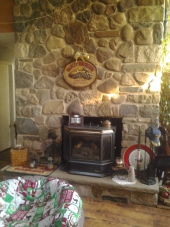I've not seen the question of scaling the plans adequately answered. Here I point at some real formulas for people to get an idea why things don't directly scale up/down. Note: This is just a rough seat-of-the-pants estimate with lots of hand waving. I'm not a fluid mechanics engineer, so I only know the general parameters, not the specifics. I've never built a
RMH, so I'm going only off what I've read here and elsewhere.
The most general form of the physical phenomenon in question: Moving any fluid such as air or
water through a pipe encounters friction.
Friction goes up with pipe length. If you have 1000' of 1" water pipe, and water valves every 100', you'll notice that the pressure and volume of water coming out of your spigots (assuming you turn only one on at a time) decrease as you get further away from your pump.Friction goes up for every bend the fluid has to move through.Friction goes up with fluid velocity. Friction goes down with increasing pipe size. These are two connected relationships, assuming a constant volume of water (gallons per minute). A larger diameter pipe means that water moves down its length slower. Slower fluid velocity means less friction.
From standard HVAC references:
https://www.captiveaire.com/MANUALS/AIRSYSTEMDESIGN/DesignAirSystems_files/image005.jpg Start by finding "DUCT DIAMETER, in." in the bottom right. Follow the diagonal lines to the upper left corner until you find '8'. That's the line we'll start with. Let's assume really low 100 cfm volume (find 100 on the horizontal axis). Find the crossing point and read the number from the vertical axis on the left and you get friction reading of 0.02 (inches of water per 100 ft of duct).
Repeat, but with a duct size of '6', and you get a friction number of 0.08! That's 4x more friction for a 56% smaller duct cross sectional area (CSA).
The only way to keep the friction the same is to reduce the volume of air. Start by finding "DUCT DUAMETER, in." in the bottom right. Find the '6' duct diameter line. Follow it until you cross the 0.02 friction line, and you'll end up off the chart, below 50 cfm.
What does this mean for a combustion unit? From the beginning: Combustion produces hot gas. That exhaust wants to rise, but is restricted by the fire box and riser core. To keep the same amount of friction, and thus to generate the same amount of lift, you'll have to move less air. Based on chimney draft formulas (See
http://en.wikipedia.org/wiki/Chimney ), a reduction of chimney area from a 8" to 6" diameter pipe is about 56%. For ease of math, let's call it half. To keep the friction the same based on the above numbers, we'll need to reduce the flow rate (cfm) by half. That means that the rest of the values must be the same, particularly chimney height! I assume that half the exhaust volume means half as much heat
energy (BTU) produced. I assume that you can produce the same hot temperature as the existing design (affects draft).
So what other parts of the system would have to change? I'd guess you
should also reduce the
cob bench mass by half and the length (heat absorption area) by half so you don't over-cool the exhaust and lose the draft in the last chimney section. I'm not sure what to do about reducing the diameter of the pipe in the cob and what effect that will have on air friction and the reduced surface area for heat transfer from the exhaust into your thermal mass. Since the core is taller relative to its reduction in diameter, the cob will likely have to be even shorter than half, since the primary heat radiating barrel is going to have proportionately more area (it's taller).
Note that there are several factors I'm ignoring:
1- 2000F air is not the same density as you'd move around in a HVAC system. It will have lower density, and thus flow easier along a given pipe.
2- I'm assuming that a clean galvanized vent duct has the same surface friction (smooth vs rough surface) as the wildly varying materials people use in their fire chimney (fire bricks of all types, refractory cement, clay, ceramics)
3- the mass and insulation of the inner fire core/riser is cooling the exhaust to the same degree, which is false, because if you have the same burn temperature, you want the same insulation thickness, and the core/riser is taller, both mean the core/riser has more mass, more surface area, so the temperature at the top will be cooler since you're putting in half as many cfm's. That means it's going to be take longer to get the fire started, and you could also end up with a backdraft during start.
4- I have no idea how much CFM the exhaust is. Assuming you have no air leaks anywhere in the system, you could measure it at the entrance or the exhaust or even the middle. At the air intake would probably be cleanest/easiest, but without an anemometer, I have no idea how you'd measure cfm at home.
Conclusion: It's possible to build a smaller stove/heater, but you cannot just scale down an existing set of plans. You need to redesign, as every part of the plumbing must be reconsidered.
For similar reasons, plumbing cold outside air to your fire box changes the way your fire performs, because you are adding friction to the air intake. If you can use a large
enough (insulated) pipe and keep it short enough, you have a chance at keeping your system the same.
If you'd like to learn more, these should be helpful:
https://www.captiveaire.com/MANUALS/AIRSYSTEMDESIGN/DESIGNAIRSYSTEMS.HTM
http://www.engineeringtoolbox.com/duct-friction-pressure-loss-d_444.html
http://sustainabilityworkshop.autodesk.com/fundamentals/reducing-heat-loss-and-air-resistance-hvac-systems
(sorry, I seem to have written a small book, not a short article highlighting the math required to recalculate air paths)















